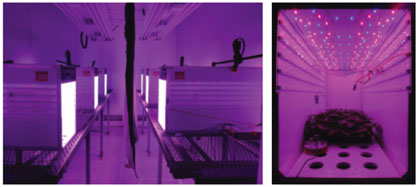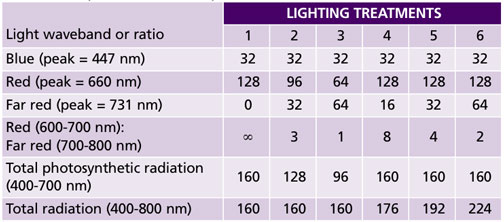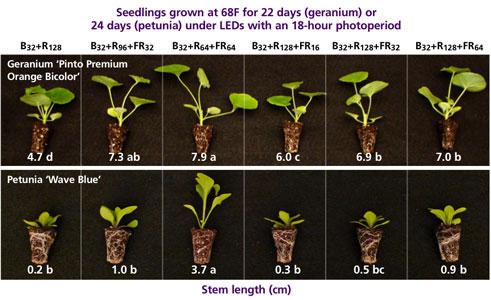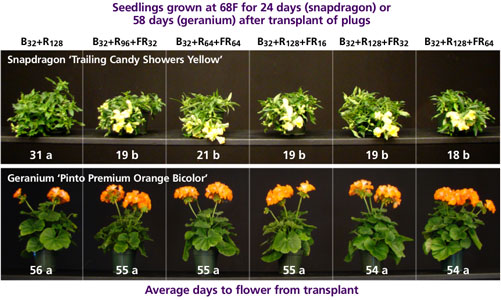10/28/2016
Red Light Spectrum
Yujin Park & Erik Runkle
Most ornamental seedling plugs are grown in greenhouses during the late winter and early spring. Thus, in the northern U.S., greenhouse growers spend a significant amount of money for heating to maintain a suitable growing temperature and supplemental lighting to increase plant quality.
In addition, with seasonal variation in climate, producing consistently high-quality plants on schedule is a major challenge. To overcome these production challenges, plugs can be grown in a completely closed production system using energy efficient light-emitting diodes (LEDs) as sole-source lighting.
When utilizing LEDs as sole-source lighting, one of the most important decisions is to determine the light spectrum to obtain desired plant responses. The radiation spectrum for LEDs is determined by the number and different colors (wavelengths) of the LEDs. An extensive amount of research has been conducted over the past few years to identify effective mixtures of different wavelengths of LEDs on a range of crops, although most of the studies have been performed on just a few crop types, such as lettuce.
A combination of blue (B; 400 to 500 nm) and red (R; 600 to 700 nm) light generally has been considered sufficient for the production of high-quality plants. This is mainly because B and R LEDs are the most energy efficient and the most efficient wavebands for driving photosynthesis in plants. Although the availability and energy efficiency of other wavebands of LEDs has been rapidly increasing, it’s generally unknown whether there are additional benefits of including additional wavebands to produce crops with
desirable characteristics, especially for ornamentals.
Including far-red (FR; 700 to 800 nm) radiation in a radiation spectrum has the potential to regulate plant architecture (such as branching and plant height) and flowering time. Although FR radiation is barely visible to the human eye, it’s absorbed by an important photoreceptor in plants called phytochrome. FR radiation regulates a wide range of plant processes—including germination, extension growth, branching and flowering—depending on the ratio of R to FR (R:FR) and the crop. The sun emits almost as much FR as R light, so plants grown indoors aren’t surprisingly different from those grown with sunlight.
Generally, as the proportion of FR radiation increases (as the R:FR decreases), stem length and leaf area increase. In addition, flowering of some long-day plants is accelerated when FR is included with R light. Thus, the absence of FR radiation in the light spectrum can suppress shoot growth and delay flower initiation or development in some common floriculture crops. Conversely, adding FR to the spectrum can increase leaf size, enabling plants to capture more light and potentially increase growth rate.
We investigated whether including FR in the light spectrum can increase the quality of ornamental seedlings. We hypothesized that leaf size would increase as more FR is added, which would increase light interception and potentially increase growth. We also proposed that including FR would lead to faster flowering of at least some long-day plants.
Experimental protocol
Seeds of Geranium Pinto Premium Orange Bicolor, Petunia Wave Blue, Snapdragon Trailing Candy Showers Yellow and Impatiens Super Elfin XP Red were sown in 128-cell plug trays. Upon emergence of the first true leaves (seven to 10 days after the seeds were sown), they were placed under six different lighting treatments. We used six customized LED growth modules located in a refrigerated walk-in growth chamber set at a constant 68F (20C) (Figure 1).
 Figure 1. Experimental setup for indoor lighting treatments included six customized LED growth modules located in a refrigerated walk-in growth chamber (left). Seedlings were grown inside each LED growth module under the lighting treatments described in Table 1 (right).
Figure 1. Experimental setup for indoor lighting treatments included six customized LED growth modules located in a refrigerated walk-in growth chamber (left). Seedlings were grown inside each LED growth module under the lighting treatments described in Table 1 (right).
Inside each LED growth module, lights operated 18 hours per day and delivered the lighting treatments in Table 1. Seedlings were evaluated when ready for transplant, which was approximately three to four weeks after growing under the LEDs. Data collected included leaf area, stem length and dry weight of shoots and roots. Dry weights are a very good indicator of plant growth.
We also wanted to determine whether the lighting treatments during the plug stage had any carry-over effects after transplant. Thus, seedlings were transplanted into 4-in. pots and subsequently grown in a common greenhouse finishing environment at 68F (20C) with a 16-hour photoperiod. We recorded days to the first open flower from transplant, the number of visible buds or inflorescences, and stem length at flowering. We repeated the experiment in time to improve confidence in the results.
Table 1. Th e intensities
e intensities
(in µmol•m–2•s–1) of different colors (wavebands) of light delivered from LEDs in six treatments and the ratios of red to far-red light. The peak of each LED color is in parentheses. All intensities were measured at plant level with a spectroradiometer.
Results
Stem elongation and leaf expansion. As FR was added up to 64 µmol•m–2•s–1 (as the R:FR decreased to 1:1), stem length and total leaf area of geranium, snapdragon and impatiens increased by 32% to 70% and 20% to 40%, respectively, compared to plants grown without FR (Figure 2). Petunia showed particularly strong extension responses to FR radiation; for example, leaves were 49% larger under an R:FR of 1:1 than those grown without FR. In all species studied, stem elongation and leaf expansion increased linearly as the amount of FR radiation increased relative to R light. Therefore, small and precise additions of FR radiation from FR LEDs can regulate extension growth to the magnitude desired.
Increase in growth. When FR was added to the same photosynthetic light intensity (treatments 1, 4, 5 and 6), shoot dry weight of geranium, petunia and snapdragon increased linearly by up to 55% to 77% as the FR intensity increased to 64 µmol•m–2•s–1. When R radiation was partially substituted with FR (treatments 1, 2 and 3), shoot dry weight of these three species was similar among treatments even though the photosynthetic light intensity was reduced by up to 40%.
 Figure 2. Plugs of geranium and petunia grown under six indoor lighting treatments delivered by blue (B), red (R) and far-red (FR) LEDs. The values after each LED color indicate their intensities in µmol•m−2•s−1. Stem length followed by different letters are significantly different.
Figure 2. Plugs of geranium and petunia grown under six indoor lighting treatments delivered by blue (B), red (R) and far-red (FR) LEDs. The values after each LED color indicate their intensities in µmol•m−2•s−1. Stem length followed by different letters are significantly different.
 Figure 3. Subsequent flowering of snapdragon and geranium after plugs were grown under six lighting treatments delivered by blue (B), red (R), and far-red (FR) LEDs. The values after each LED color indicate their intensities in µmol•m−2•s−1. Average days to flower from transplant followed by different letters are significantly different.
Figure 3. Subsequent flowering of snapdragon and geranium after plugs were grown under six lighting treatments delivered by blue (B), red (R), and far-red (FR) LEDs. The values after each LED color indicate their intensities in µmol•m−2•s−1. Average days to flower from transplant followed by different letters are significantly different.
These results, and the effects on leaf area, suggest that inclusion of FR radiation can increase growth of plants that grow best under high light. In contrast, extension growth of impatiens (a shade-tolerant plant) wasn’t very sensitive to FR radiation. Shoot dry weight wasn’t affected by the addition of FR and it decreased when R radiation was partly substituted with FR. There was little or no effect of radiation treatments on root dry weight of all species.
Subsequent flowering. Subsequent flowering of the long-day plant snapdragon was promoted by 10 to 12 days when FR was added during the seedling stage (Figure 3). It appears as though the lowest intensity of FR (16 µmol•m–2•s–1) saturated the flowering response because higher intensities didn’t further accelerate flowering. In petunia, also a long-day plant, the number of visible buds at flowering decreased under the lowest R:FR (1:1), but flowering time and stem length at flowering weren’t influenced by FR treatments during seedling stage. The lighting treatments had no effect on flowering of the day-neutral species geranium and impatiens.
Conclusions
In this study, we showed that adding FR radiation to the radiation spectrum of sole-source lighting promoted ornamental seedling growth, at least partly by increasing leaf size, which enabled plants to capture more light. In addition, inclusion of FR during the seedling stage promoted subsequent flowering in one of the long-day crops studied. Not surprisingly, responses to FR radiation varied somewhat among the different species and plant parameters (such as stem elongation, leaf expansion and flowering). Thus, more research on a range of floriculture crops is necessary to better understand how FR radiation can improve ornamental seedling production.
GT
Yujin Park (parkyuj2@msu.edu) is a Ph.D. student and Erik Runkle (runkleer@msu.edu) is a professor and floriculture extension specialist in the Department of Horticulture at Michigan State University. The authors thank support from Osram Opto Semiconductors, the USDA-ARS Floriculture and Nursery Research Initiative, MSU’s Project GREEEN and companies supportive of MSU floriculture research. They also thank C. Raker & Sons for donation of plant material and Nate DuRussel for technical assistance.